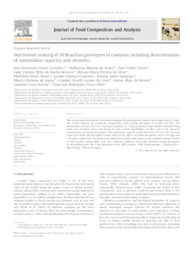Nutritional ranking of 30 Brazilian genotypes of cowpeas including determination of antioxidant capacity and vitamins.
Nutritional ranking of 30 Brazilian genotypes of cowpeas including determination of antioxidant capacity and vitamins.
Summary: This study aimed to establish a nutritional ranking of 30 genotypes of cowpea (Vigna unguiculata L. Walp). The results showed the proximate composition varies among genotypes in protein (20?30%) and dietary fiber contents (20?35%), in protease inhibitors (2?4 UI/mg protein), lectin (40,000?640,000 UH/kg meal) and essential amino acid levels, in vitro protein digestibility (30?40%) and in the apparent concentration of expressed proteins. The antioxidant capacity varied from EC50 of 9.54?38.7 mg seed extract/mL DPPH and the highest values detected for alpha- and delta-tocopherol were 0.38 mg/g and 1.88 mg/g, respectively. The analysis of a nutritional quality index based on the weighted average content of total protein, dietary fiber, iron, zinc, protease inhibitors and lectins allowed ranking genotypes. In descending order the 5 best genotypes were: BRS-Cauamé> BRS-Tumucumaque> Canapuzinho> BRS-Potengi> BRS-Urubuquara.
Publication year: 2012
Types of publication: Journal article
Unit: Embrapa Mid-North
Observation
Some of Embrapa's publications are published as ePub files. To read them, use or download one of the following free software options to your computer or mobile device. Android: Google Play Books; IOS: iBooks; Windows and Linux: Calibre.
Access other publications
Access the Agricultural Research Database (BDPA) to consult Embrapa's full library collection and records.
Visit Embrapa Bookstore to purchase books and other publications sold by Embrapa.

